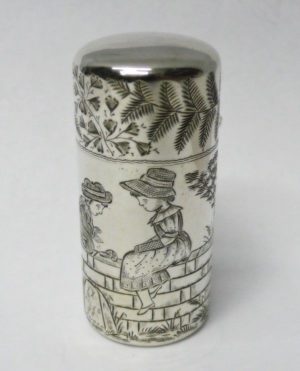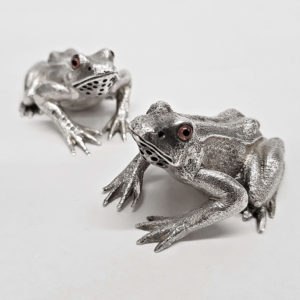Sampson Mordan & Co
Sampson Mordan (1770-1843), apprenticed to the mechanic John Bramah, established his own business in 1815.
The first patent for a propelling pencil was obtained in 1822 (his co-inventor was John Isaac Hawkins). In 1823 Mordan bought out the rights of Hawkins, and entered into partnership with Gabriel Riddle manufacturing silver mechanical pencils with the marking “SMGR” until 1836 when the partnership was dissolved and the business became S. Mordan & Co.
Sampson Mordan died in 1843 and the business was taken over by his sons Sampson (Jr) and Augustus, They were later joined by Edmund George Johnson and Zachariah Watkins who retired in 1879. In 1898 the company became the limited liability company S. Mordan & Co Ltd. In 1933 the distribution rights on the propelling pencil business were given to L. G. Sloan Ltd, and in 1941, following the destruction of the factory by enemy bombing, the patents were sold to Edward Baker. The firm went into voluntary liquidation in 1952.
In addition to pencils the firm had a large production line of small silver and gold items, most of them belonging to the type of “novelties” so popular at the end of the 19th/beginning of the 20th century. They were supplied to many retailers, including Asprey & Sons and the Goldsmiths & Silversmiths Co. Ltd. Sampson Mordan & Co was present at the 1851 London Great Exhibition and at the 1922 and 1929 British Industries Fair.
Sampson Mordan & Co
Sampson Mordan (1770-1843), apprenticed to the mechanic John Bramah, established his own business in 1815.
The first patent for a propelling pencil was obtained in 1822 (his co-inventor was John Isaac Hawkins). In 1823 Mordan bought out the rights of Hawkins, and entered into partnership with Gabriel Riddle manufacturing silver mechanical pencils with the marking “SMGR” until 1836 when the partnership was dissolved and the business became S. Mordan & Co.
Sampson Mordan died in 1843 and the business was taken over by his sons Sampson (Jr) and Augustus, They were later joined by Edmund George Johnson and Zachariah Watkins who retired in 1879. In 1898 the company became the limited liability company S. Mordan & Co Ltd. In 1933 the distribution rights on the propelling pencil business were given to L. G. Sloan Ltd, and in 1941, following the destruction of the factory by enemy bombing, the patents were sold to Edward Baker. The firm went into voluntary liquidation in 1952.
In addition to pencils the firm had a large production line of small silver and gold items, most of them belonging to the type of “novelties” so popular at the end of the 19th/beginning of the 20th century. They were supplied to many retailers, including Asprey & Sons and the Goldsmiths & Silversmiths Co. Ltd. Sampson Mordan & Co was present at the 1851 London Great Exhibition and at the 1922 and 1929 British Industries Fair.
-


1893
Sampson Mordan & Co
8240 Antique Silver Perfume Bottle by Sampson Mordan
Sold
A delightful sterling silver cylinder scent bottle, with a hinged flip top and glass stopper. The bottle is finely engraved in the Kate Greenaway style, with two little girls sitting on a wall looking at a snail, there is a church in the background. Original gilt interior. Height 5.5 cms. Diameter 2.5 cms. London 1893. Maker Sampson Mordan & Co.
-


1881
Sampson Mordan & Co
9372 Antique Silver Frog Peppers
Sold
A rare and excellent quality pair of novelty silver pepperettes modelled in the form of crouching frogs. The chased decoration is very fine, crisp and realistic. Bead eyes. The pepper pours from the pierced holes representing the frog’s nostrils and wind sac. The pepper is filled via a screw cover to the underside. Total weight 171 grams, 5.4 troy ounces. Length 6.7cm. Width 4.5 cm. London 1881. Maker Sampson Mordan.